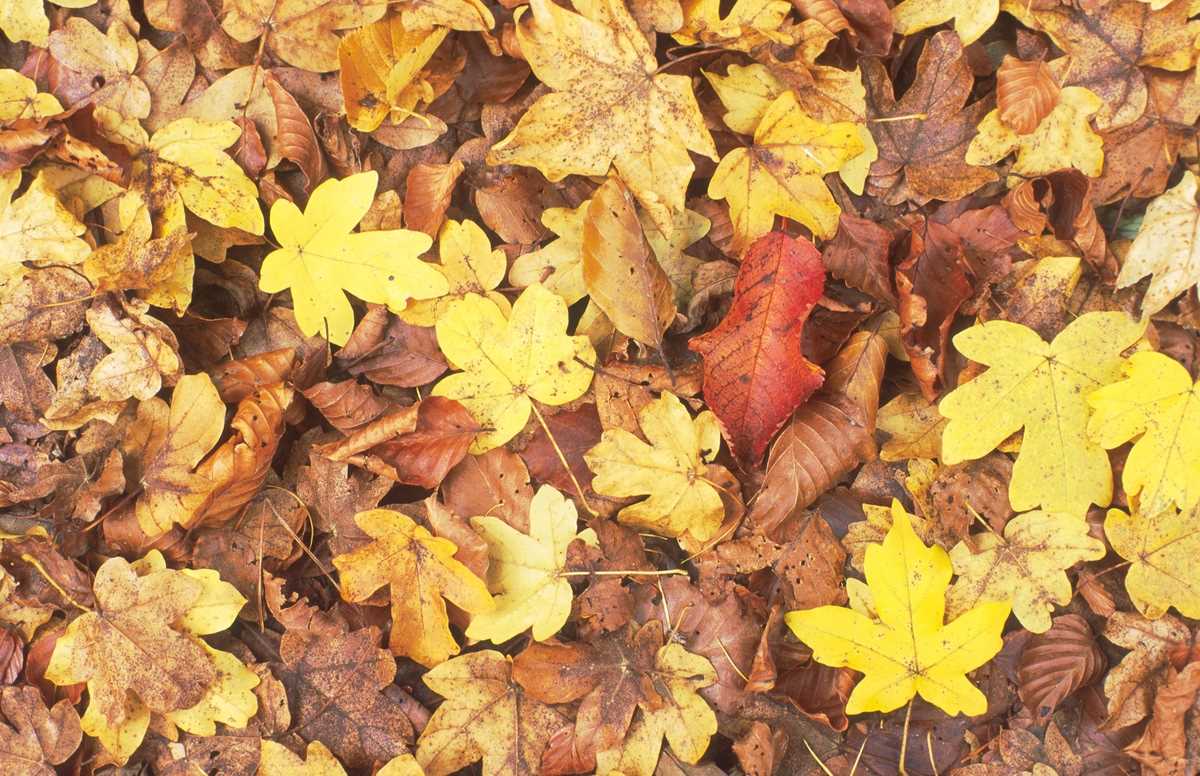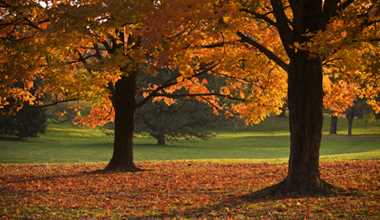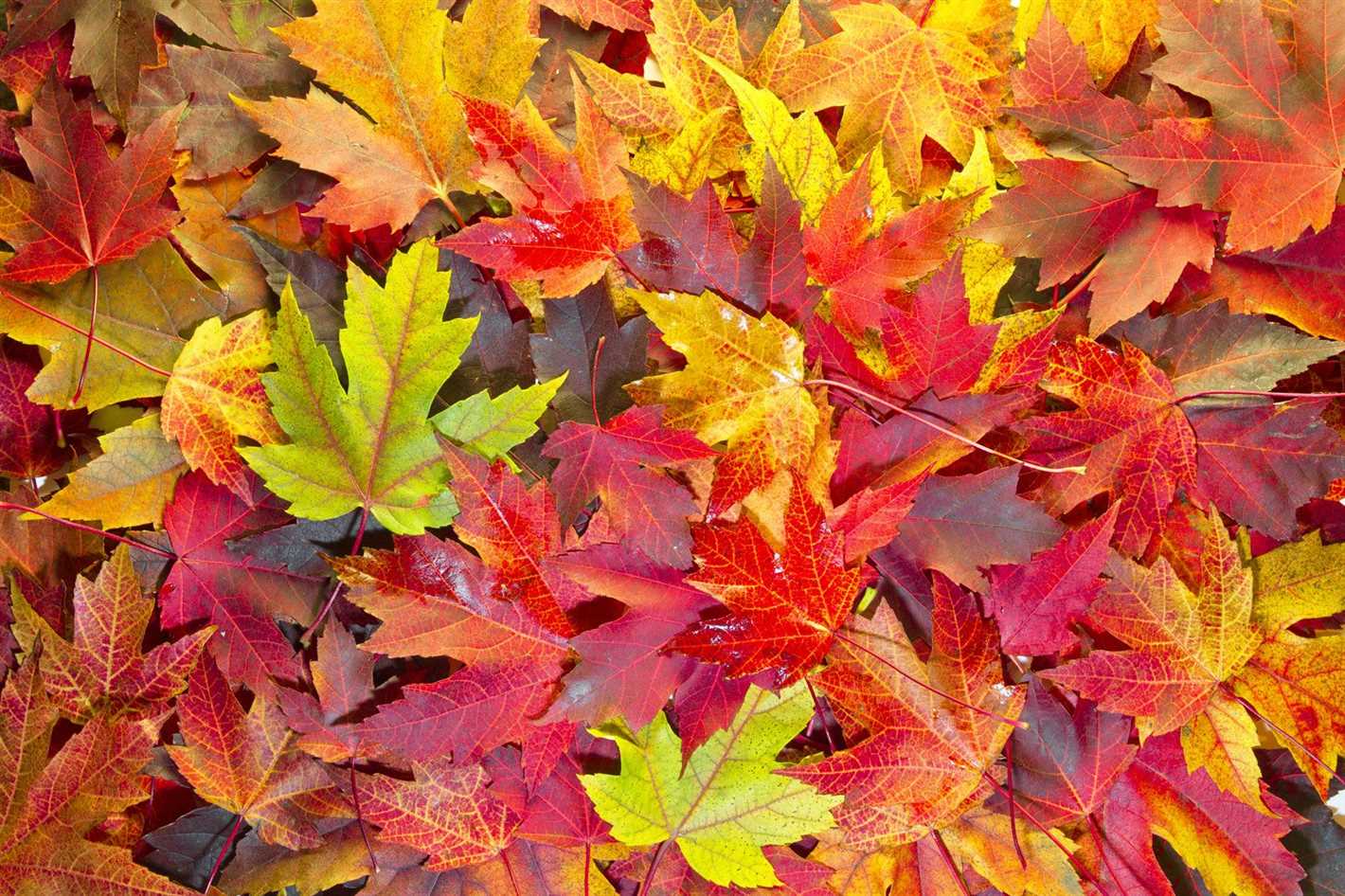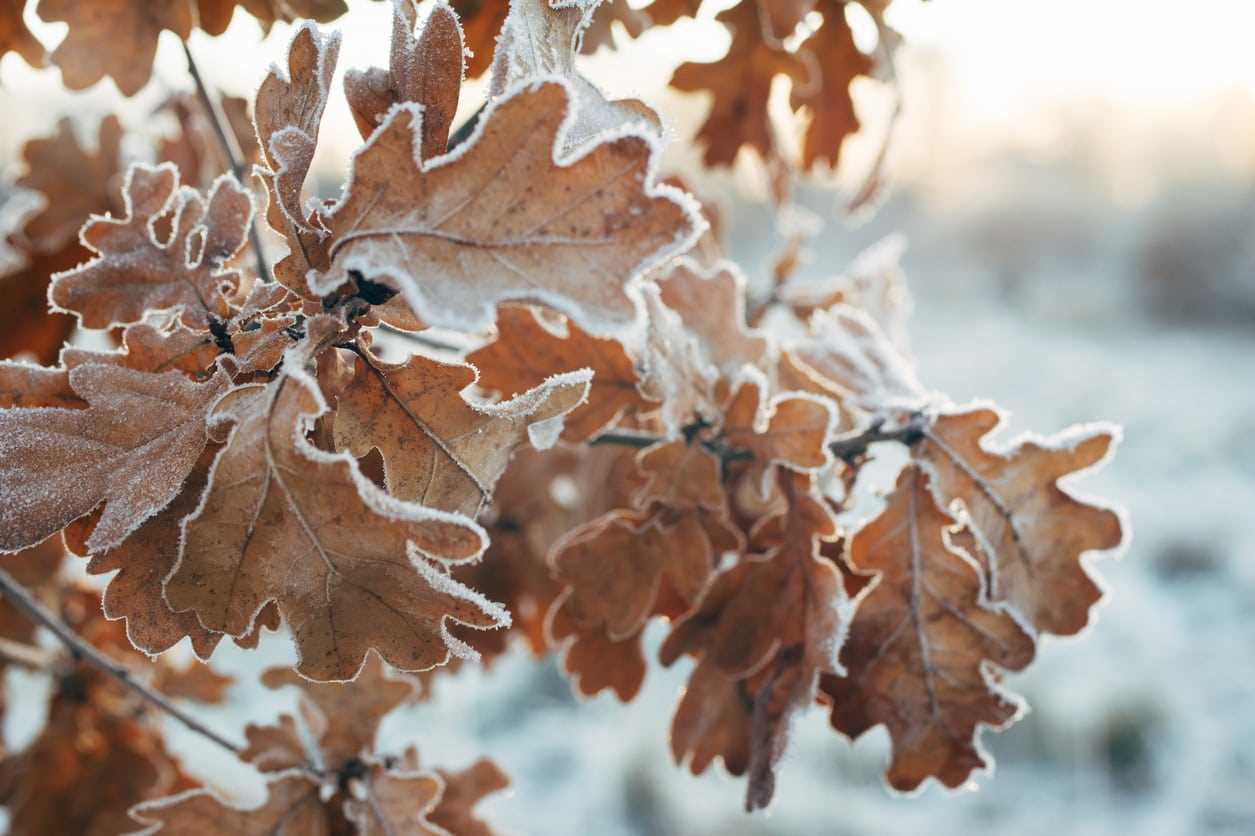- Lack of Temperature Change
- Insufficient Daylight Hours
- Abundance of Water
- Nutrient Deficiencies
- Pruning and Trimming
- Benefits of Pruning
- Trimming Techniques
- When to Prune
- Hiring a Professional
- Adjusting Light Exposure
- Managing Watering Frequency
- 1. Assess the specific needs of your plants
- 2. Check the soil moisture
- 3. Water deeply and infrequently
- 4. Use the right watering technique
- 5. Adjust watering frequency based on environmental factors
- Fertilizer Application
- 1. Soil Testing
- 2. Timing
- 3. Choosing the Right Fertilizer
- 4. Proper Application Techniques
- Questions and Answers:
- Why do leaves fall in autumn?
- Are there any trees that don’t lose their leaves in autumn?
- Are there any diseases that can prevent leaves from falling in autumn?
- Can environmental factors affect the timing of leaf fall in autumn?
- What are the consequences of leaves not falling in autumn?
- What can be done to prevent leaves from falling in autumn?
- Videos: 4 reasons for tiny leaves

Autumn is typically known as the season when leaves change color and fall from trees. However, there are instances when leaves don’t fall as expected. This can be a cause of concern for many individuals who are used to the natural cycle of trees shedding their foliage. In this article, we will explore four common reasons why leaves may not fall in autumn and provide potential solutions.
1. Unseasonably warm weather: One of the primary reasons why leaves may not fall in autumn is due to unseasonably warm weather. When temperatures remain high for an extended period, trees may delay the process of shedding their leaves. This can be confusing for both nature enthusiasts and those who rely on the changing seasons as a marker of time. To address this issue, individuals can make small adjustments to their watering and feeding routines to help encourage leaf shedding.
2. Nutrient deficiencies: Another common reason why leaves may not fall in autumn is nutrient deficiencies. Trees require a balance of essential nutrients to properly enter their dormant stage and shed their leaves. If the soil lacks necessary nutrients, such as nitrogen or potassium, trees may not have the energy to complete the natural leaf-shedding process. By analyzing the soil and providing the appropriate nutrient treatments, individuals can help ensure trees have the necessary resources to shed their leaves.
“Autumn is a second spring when every leaf is a flower.” – Albert Camus
3. Environmental factors: Environmental factors such as pollution, drought, or excessive rain can also impact leaf shedding in autumn. Pollutants in the air can inhibit the natural processes of trees, causing leaves to stay on longer than usual. Similarly, drought conditions can lead to leaves staying attached to branches as the tree conserves energy. Excessive rainfall can have a similar effect, as it can wash away the natural triggers for leaf shedding. Removing or mitigating these environmental factors can help encourage the natural autumn leaf-shedding process.
4. Underlying health issues: Lastly, underlying health issues can also contribute to leaves not falling in autumn. Trees that are stressed or infected with diseases may not have the strength or ability to shed their foliage on schedule. In such cases, it is important to address the underlying health issues through proper tree care and potential treatments to ensure the tree’s overall well-being and encourage the natural cycle of leaf shedding.
In conclusion, there are several common reasons why leaves may not fall in autumn, including unseasonably warm weather, nutrient deficiencies, environmental factors, and underlying health issues. By understanding these reasons and implementing appropriate solutions, individuals can help their trees go through the natural cycle of leaf shedding and maintain their overall health and beauty.
Lack of Temperature Change
One common reason why leaves may not fall in autumn is a lack of significant temperature change. Temperature plays a crucial role in the process of leaf senescence, which is the gradual dying off of leaves in preparation for winter.
During autumn, the days become shorter and temperatures start to drop. These changes trigger chemical processes within the leaves that cause them to change color and eventually fall off. However, if there is a lack of temperature change, such as in regions with a more stable climate, the leaves may not receive the necessary signals to enter the senescence phase.
In such cases, it may appear as if the leaves are not falling, but rather staying attached to the trees for extended periods. This phenomenon can be observed in areas with mild or tropical climates, where the temperatures do not fluctuate significantly between seasons.
To address the lack of temperature change, there are a few potential solutions:
- Introduce artificial temperature fluctuations: In controlled environments such as greenhouses, it is possible to simulate the temperature changes associated with autumn. By exposing the trees to cooler temperatures for a certain period of time, the leaves may receive the necessary cues to initiate senescence and eventually fall off.
- Plant species adapted to stable climates: Certain tree species have evolved to thrive in regions with stable or tropical climates. These species are more likely to retain their leaves throughout the year and may not exhibit the typical autumn leaf-falling behavior. If desired, selecting such species for landscaping can help maintain a lush, green appearance even in the absence of traditional autumn foliage.
- Implement a nutrient management strategy: If the lack of temperature change affects the overall health of the trees, it may be necessary to implement a nutrient management strategy. Providing adequate nutrients, such as nitrogen and phosphorus, can help maintain the vitality of the trees and support healthy leaf growth throughout the year.
It is important to note that a lack of temperature change and subsequent absence of autumn leaf-falling behavior may not necessarily indicate a problem. In certain climates, it is simply a natural adaptation of the trees to their environment. However, if the lack of leaf-fall is accompanied by other concerning signs of tree health, it is advisable to consult a professional arborist for further evaluation and guidance.
Insufficient Daylight Hours
One common reason why leaves don’t fall in autumn is insufficient daylight hours. During the autumn season, the days become shorter and the nights become longer. This change in daylight hours signals to trees that it is time to prepare for winter. However, if there is insufficient daylight, the trees may not receive the necessary cues to shed their leaves.
The amount of daylight a tree receives depends on its geographic location and the time of year. Trees in regions closer to the equator generally have a more consistent amount of daylight throughout the year, while trees in higher latitudes experience more dramatic changes in daylight hours between seasons.
When there are insufficient daylight hours, trees may not go through the normal physiological processes that trigger leaf senescence and leaf abscission. Leaf senescence refers to the aging of the leaves, while leaf abscission is the process of shedding the leaves. These processes are controlled by hormones within the tree, which are triggered by changes in daylight duration.
To help address the issue of insufficient daylight hours, there are a few solutions. One option is to provide artificial light to compensate for the lack of natural daylight. This can be done through the use of grow lights or light-emitting diodes (LEDs) that mimic the spectrum of natural sunlight.
Another solution is to ensure that trees are planted in locations that receive sufficient daylight throughout the year. This may involve considering the orientation of the tree in relation to the sun and selecting tree species that are better adapted to the local climate.
Overall, addressing the issue of insufficient daylight hours can help ensure that trees go through the natural processes of leaf senescence and leaf abscission in autumn. By providing the necessary cues, trees can effectively prepare for winter and shed their leaves when appropriate, contributing to the beauty and cycle of the changing seasons.
Abundance of Water
If leaves are not falling in autumn, one common reason could be an abundance of water. When trees receive too much water, their roots become saturated, leading to a lack of oxygen and poor nutrient uptake. As a result, the leaves do not receive the signals to detach and fall off in autumn.
There are several potential causes of an abundance of water around trees:
- Excessive rainfall: Heavy and prolonged rainfall can saturate the soil, causing water to accumulate around tree roots.
- Poor drainage: If the soil does not drain well or if there are drainage issues in the surrounding area, water may pool around the trees.
- Overwatering: Human intervention, such as overwatering trees or nearby irrigation systems, can lead to excessive water around the roots.
To address an abundance of water and promote leaf fall in autumn, several solutions can be implemented:
- Improve drainage: Ensuring that the soil drains well and there are no obstructions in drainage pathways can help prevent water accumulation.
- Reduce watering: If overwatering is the issue, adjusting irrigation schedules and reducing the amount of water applied can help restore a balance.
- Create a gradient: Modifying the landscape to create a gentle slope away from tree roots can help divert excess water and prevent pooling.
- Monitor rainfall: Keeping track of rainfall patterns and adjusting watering schedules accordingly can prevent waterlogging.
By addressing an abundance of water, trees can receive the proper oxygen and nutrients they need, allowing their leaves to naturally detach and fall off in autumn.
Nutrient Deficiencies
Nutrient deficiencies can also cause leaves to not fall in autumn. When plants are not getting enough essential nutrients, their leaf development and shedding process can be disrupted. Here are some common nutrient deficiencies that can lead to leaves not falling:
Nitrogen deficiency:
Nitrogen is an essential nutrient for leaf development and growth. When plants lack nitrogen, their leaves may remain green and not senesce or fall off properly.
Phosphorus deficiency:
Phosphorus is crucial for energy transfer and is involved in various metabolic processes in plants. When plants lack phosphorus, their leaves may turn dark green or develop reddish or purplish hues, but still not fall off.
Potassium deficiency:
Potassium is necessary for maintaining healthy cell functions and water regulation in plants. When plants lack potassium, their leaves may show symptoms such as yellowing and necrosis, but not necessarily fall off.
Magnesium deficiency:
Magnesium is a central component of the chlorophyll molecule, which is responsible for the green color in plants. When plants lack magnesium, their leaves may exhibit interveinal chlorosis (yellowing between the veins) but may not detach from the plant.
If you suspect nutrient deficiencies to be the cause of leaves not falling in autumn, it is important to conduct a soil test to determine the specific nutrient imbalances. Once identified, appropriate fertilizers or soil amendments can be applied to address the deficiencies and promote normal leaf shedding.
Pruning and Trimming
Pruning and trimming are important practices for maintaining healthy trees and preventing leaves from falling prematurely in autumn. Regular pruning helps to remove dead or damaged branches, improves air circulation, and allows sunlight to reach the lower parts of the tree.
Benefits of Pruning


- Promotes new growth: Pruning stimulates the growth of new branches and leaves, encouraging a healthier and denser tree canopy.
- Enhances tree structure: Pruning helps to shape the tree and improve its overall structure, making it more resistant to storms and high winds.
- Removes diseased and damaged branches: Regular pruning allows for the removal of weakened branches that may be affected by diseases or pest infestations.
- Prevents risk of accidents: Pruning minimizes the risk of falling branches, which can cause property damage or injury to people.
Trimming Techniques
When it comes to trimming trees, it’s important to follow proper techniques to avoid damaging the tree and promote healthy growth.
- Crown thinning: This technique involves selectively removing branches to reduce the density of the tree canopy. It helps improve air circulation and allows more sunlight to reach the lower branches and leaves.
- Crown raising: Raising the crown involves removing the lower branches to provide clearance for pedestrians, vehicles, or buildings.
- Crown reduction: Crown reduction involves reducing the overall size of the tree’s canopy. It helps to balance the tree’s size with the available root system and can prevent the tree from becoming top-heavy.
- Branch collar pruning: When pruning branches, it’s important to make cuts just beyond the branch collar – the swollen area where the branch joins the trunk. This promotes proper healing and prevents the risk of disease or decay.
When to Prune
The timing of pruning depends on the specific tree species and its growth habits. In general, it’s best to prune during the dormant season, which is typically in late winter or early spring. Pruning during this time minimizes stress on the tree and allows for faster healing of pruning wounds.
Hiring a Professional
While small pruning and trimming tasks can be done by homeowners, it’s often recommended to hire a professional arborist for larger or more complex jobs. A professional arborist has the knowledge, skills, and equipment to safely and effectively prune trees without causing harm.
| Advantages of Hiring a Professional | Disadvantages of DIY Pruning |
|---|---|
|
|
By practicing proper pruning and trimming techniques or hiring a professional, you can help maintain the health and vitality of your trees, preventing premature leaf fall in autumn.
Adjusting Light Exposure
One common reason why leaves may not fall in autumn is due to insufficient light exposure. Leaves require a certain amount of light to trigger the onset of senescence, which is the process that leads to leaf shedding. If a plant is not receiving enough light, it may delay leaf drop.
To address this issue, it is important to ensure that your plants are receiving adequate light exposure. Here are some solutions:
- Position plants strategically: Observe the amount of sunlight different areas of your garden receive throughout the day. Place plants that require more light in areas with direct sunlight, and those that can tolerate shade in areas with less sun exposure.
- Prune nearby trees or shrubs: If your plants are being shaded by nearby trees or shrubs, consider pruning them to allow more light to reach your plants. Be careful not to remove too much foliage, as it may expose your plants to excessive sunlight and heat.
- Use supplemental lighting: If your plants are not getting enough natural light, you can supplement their exposure with artificial lighting. Grow lights can provide the necessary light spectrum and intensity to promote healthy leaf drop.
- Adjust light duration: Some plants require specific day length or photoperiods to initiate leaf shedding. If you are growing such plants, you may need to adjust the light duration by using blinds or artificial covers to mimic shorter days.
By adjusting light exposure according to the needs of your plants, you can encourage the natural process of leaf shedding in autumn.
Managing Watering Frequency


Watering your plants is an essential part of keeping them healthy and preventing leaf drop. However, it’s important to water them correctly, as both overwatering and underwatering can lead to leaf loss. Here are some tips for managing watering frequency:
1. Assess the specific needs of your plants
Different plants have different watering requirements. Some plants, like succulents, prefer dry conditions and can tolerate long periods without water, while others, like ferns, need consistently moist soil. Research the specific needs of your plants to determine the ideal watering frequency.
2. Check the soil moisture
Before watering your plants, check the moisture level of the soil. Stick your finger about an inch deep into the soil. If it feels dry at that depth, it’s time to water. However, if the soil feels slightly damp, it’s better to wait before watering again.
3. Water deeply and infrequently


Instead of watering your plants lightly every day, it’s better to water them deeply and less frequently. This encourages the roots to grow deeper and makes them more resilient to dry conditions. Make sure to water the soil directly and avoid getting the leaves wet, as this can promote the development of diseases.
4. Use the right watering technique


Depending on the type of plants you have, there are different watering techniques you can use. For example, using a drip irrigation system or a soaker hose can provide a slow and steady water supply to the roots. Alternatively, you can also use a watering can or hose with a gentle spray nozzle to water the plants evenly.
5. Adjust watering frequency based on environmental factors
Environmental factors like temperature, humidity, and season can affect the watering needs of your plants. In hot and dry weather, you may need to water more frequently, while in cooler and more humid weather, you can reduce the watering frequency. Keep an eye on the weather forecast and adjust your watering schedule accordingly.
Remember, finding the right watering frequency for your plants may require some trial and error. Monitor their response and adjust accordingly. By managing watering frequency properly, you can help prevent leaf drop and keep your plants healthy and vibrant.
Fertilizer Application
Fertilizer application is an essential step in maintaining healthy and vibrant leaves throughout the autumn season. By providing the necessary nutrients, you can ensure that your trees are able to withstand the environmental changes and keep their leaves intact. Here are some common methods and tips for applying fertilizer:
1. Soil Testing
Before applying any fertilizer, it is important to conduct a soil test to determine the nutrient needs of your trees. This will help you identify any deficiencies and select the appropriate fertilizer blend. Soil tests can be done using DIY kits or by sending samples to a professional laboratory.
2. Timing
The timing of fertilizer application is crucial for its effectiveness. It is recommended to apply fertilizer in early spring or late summer, before the trees enter the dormancy phase. This allows the roots to absorb the nutrients and prepare the tree for the upcoming autumn season.
3. Choosing the Right Fertilizer
There are various types of fertilizers available, including organic and synthetic options. Organic fertilizers, such as compost or manure, are slow-release and provide a steady supply of nutrients over time. Synthetic fertilizers, on the other hand, are fast-acting and deliver nutrients more quickly. Choose a fertilizer that suits the specific needs of your trees and follow the manufacturer’s instructions for application rates.
4. Proper Application Techniques
When applying fertilizer, it is important to follow proper techniques to ensure optimal absorption and minimize potential damage. Avoid applying fertilizer directly on the trunk of the tree, as it can cause burning. Instead, spread the fertilizer evenly around the drip line, which is the area beneath the outer edges of the branches. To prevent runoff, water the area lightly after applying fertilizer.
Remember, fertilizing your trees in the right way can greatly enhance their ability to retain leaves during autumn. Consult with a professional arborist or your local gardening center for further guidance on selecting and applying the appropriate fertilizer for your specific tree species. With proper fertilizer application, you can enjoy vibrant and healthy autumn leaves year after year.
Questions and Answers:
Why do leaves fall in autumn?
Leaves fall in autumn because the trees prepare for the winter season. As temperatures drop and the days become shorter, trees begin to produce less chlorophyll, the pigment that gives leaves their green color. This reduction in chlorophyll production causes other pigments, such as yellow and orange, to become visible. Eventually, a layer of cells forms at the base of each leaf, cutting off its supply of water and nutrients. This leads to the leaf drying out and eventually falling off the tree.
Are there any trees that don’t lose their leaves in autumn?
Yes, there are some trees that do not lose their leaves in autumn. These trees are known as evergreen trees. Evergreen trees, such as pine, spruce, and fir trees, have leaves or needles that remain green and on the tree throughout the entire year. They do not shed their leaves like deciduous trees. Evergreen trees have adapted to cold temperatures and are able to survive the winter without losing their leaves.
Are there any diseases that can prevent leaves from falling in autumn?
Yes, there are several diseases that can prevent leaves from falling in autumn. One common disease is called anthracnose. Anthracnose is a fungal disease that affects a wide range of trees and shrubs. It causes dark spots or blotches on the leaves and can lead to defoliation. Another disease that can prevent leaves from falling is powdery mildew. Powdery mildew is a fungal disease that causes a white, powdery coating to appear on the leaves. This can disrupt the normal process of leaf abscission and result in leaves remaining on the tree.
Can environmental factors affect the timing of leaf fall in autumn?
Yes, environmental factors can affect the timing of leaf fall in autumn. Some of the main factors that can influence when leaves fall include temperature, sunlight, and moisture levels. If there is an early frost or a prolonged period of warm weather in the fall, this can cause leaves to fall earlier or later than normal. Additionally, if there is a lack of sunlight or if the soil is too dry, trees may hold onto their leaves for longer in an effort to maximize their remaining resources. Environmental factors play a significant role in leaf abscission.
What are the consequences of leaves not falling in autumn?
If leaves do not fall in autumn, it can have several consequences for both the tree and the surrounding ecosystem. One consequence is that the tree may have a reduced ability to gather sunlight and produce food through photosynthesis. Since leaves are responsible for capturing sunlight and converting it into energy, if they do not fall, the tree may struggle to survive through the winter and may have stunted growth in the following spring. Additionally, leaves that do not fall can create a breeding ground for pests and diseases, as pathogens may overwinter on the leaves and infect the tree in the future. The decomposition of leaves is also an important part of nutrient recycling in ecosystems, so if leaves do not fall, it can disrupt this cycle and impact other organisms in the ecosystem.
What can be done to prevent leaves from falling in autumn?
Preventing leaves from falling in autumn is generally not recommended, as it is a natural process that trees undergo to prepare for the winter. However, there are some instances where leaf retention may be desired, such as for aesthetic purposes or to protect young trees from harsh weather conditions. In these cases, some techniques can be used to retain leaves. One method is to provide additional water and nutrients to the tree, which can help prolong the life of the leaves. Pruning branches can also help reduce leaf drop. However, it is important to consult with a professional arborist before attempting to prevent leaf fall, as it can have negative consequences for the tree’s health and overall well-being.







